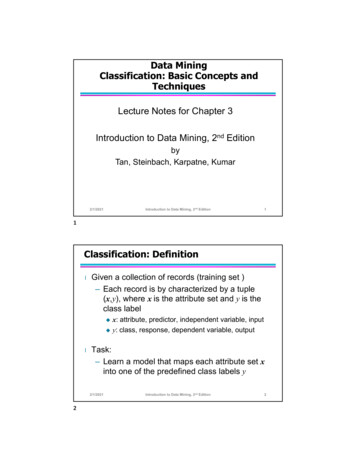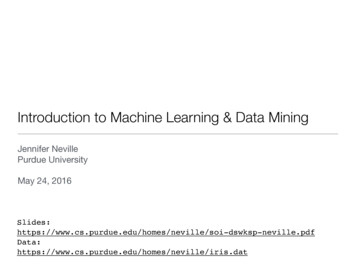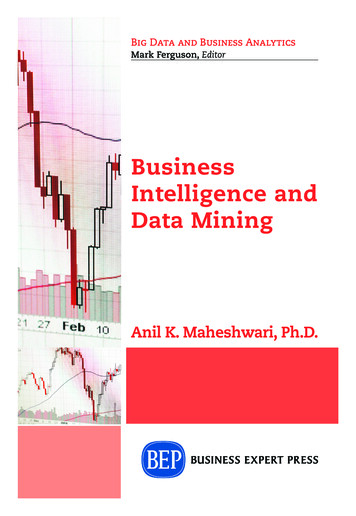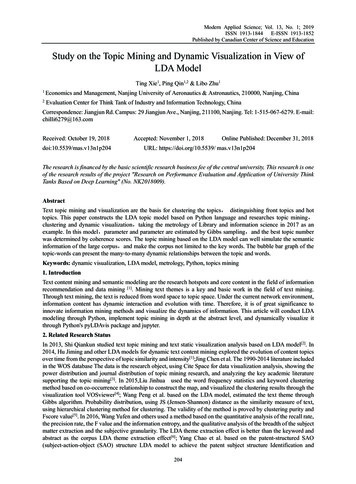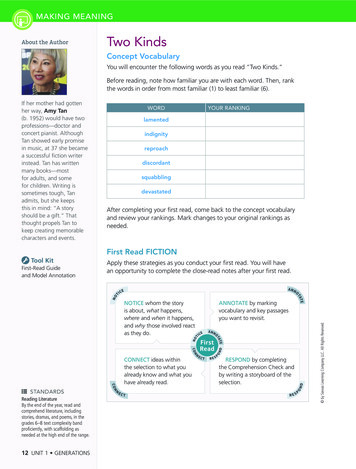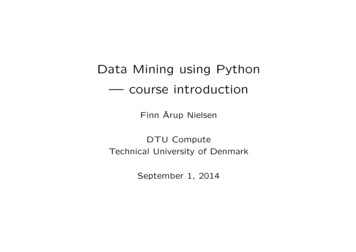
Transcription
Continue
Introduction to data mining tan steinbach kumar pdf downloadStart your free trial today and explore our endless library.Pang-Ning Tan, Michael Steinbach, Vipin KumarShare book736 pagesEnglishPDFNot available on the Perlego appPang-Ning Tan, Michael Steinbach, Vipin KumarBook detailsTable of contentsIntroduction to Data Mining presents fundamental concepts and algorithms for those learning data mining forthe first time. Each concept is explored thoroughly and supported with numerous examples. The text requires only a modest background in mathematics.Each major topic is organized into two chapters, beginning with basic concepts that provide necessary background for understanding each data mining technique, followed by more advanced concepts andalgorithms.QuotesThis book provides a comprehensive coverage of important data mining techniques.Numerous examples are provided to lucidly illustrate the key concepts.-Sanjay Ranka, University of FloridaIn my opinion this is currently the best data mining text book on the market. I like the comprehensive coverage which spans all major data miningtechniques including classification, clustering, and pattern mining (association rules).-Mohammed Zaki, Rensselaer Polytechnic InstituteRead More 1 Tan,Steinbach, Kumar Introduction to Data Mining 1/17/2006 1 Data Mining Cluster Analysis: Advanced Concepts and Algorithms Figures for Chapter 9 Introduction to Data Mining by Tan, Steinbach, Kumar Tan,Steinbach, Kumar Introduction to Data Mining 4/18/2004 1 2 Tan,Steinbach, Kumar Introduction to Data Mining 1/17/2006 2 3 Tan,Steinbach, Kumar Introduction to Data Mining 1/17/2006 3 4 Tan,Steinbach, Kumar Introduction to Data Mining 1/17/2006 4 5 Tan,Steinbach, Kumar Introduction to Data Mining 1/17/2006 5 6 Tan,Steinbach, KumarIntroduction to Data Mining 1/17/2006 6 7 Tan,Steinbach, Kumar Introduction to Data Mining 1/17/2006 7 8 Tan,Steinbach, Kumar Introduction to Data Mining 1/17/2006 8 9 Tan,Steinbach, Kumar Introduction to Data Mining 1/17/2006 9 10 Tan,Steinbach, Kumar Introduction to Data Mining 1/17/2006 10 11 Tan,Steinbach, Kumar Introduction toData Mining 1/17/2006 11 12 Tan,Steinbach, Kumar Introduction to Data Mining 1/17/2006 12 13 Tan,Steinbach, Kumar Introduction to Data Mining 1/17/2006 13 14 Tan,Steinbach, Kumar Introduction to Data Mining 1/17/2006 14 15 Tan,Steinbach, Kumar Introduction to Data Mining 1/17/2006 15 16 Tan,Steinbach, Kumar Introduction to DataMining 1/17/2006 16 17 Tan,Steinbach, Kumar Introduction to Data Mining 1/17/2006 17 18 Tan,Steinbach, Kumar Introduction to Data Mining 1/17/2006 18 19 Tan,Steinbach, Kumar Introduction to Data Mining 1/17/2006 19 20 Tan,Steinbach, Kumar Introduction to Data Mining 1/17/2006 20 21 Tan,Steinbach, Kumar Introduction to Data Mining1/17/2006 21 22 Tan,Steinbach, Kumar Introduction to Data Mining 1/17/2006 22 23 Tan,Steinbach, Kumar Introduction to Data Mining 1/17/2006 23 24 Tan,Steinbach, Kumar Introduction to Data Mining 1/17/2006 24 25 Tan,Steinbach, Kumar Introduction to Data Mining 1/17/2006 25 26 Tan,Steinbach, Kumar Introduction to Data Mining1/17/2006 26 27 Tan,Steinbach, Kumar Introduction to Data Mining 1/17/2006 27 28 Tan,Steinbach, Kumar Introduction to Data Mining 1/17/2006 28 29 Tan,Steinbach, Kumar Introduction to Data Mining 1/17/2006 29 Introduction to Data Mining presents fundamental concepts and algorithms for those learning data mining for the first time. Eachconcept is explored thoroughly and supported with numerous examples. The text requires only a modest background in mathematics. Each major topic is organised into two chapters, beginning with basic concepts that provide necessary background for understanding each data mining technique, followed by more advanced concepts and algorithms. The fulltext downloaded to your computer With eBooks you can: search for key concepts, words and phrases make highlights and notes as you study share your notes with friends eBooks are downloaded to your computer and accessible either offline through the Bookshelf (available as a free download), available online and also via the iPad and Android apps. Uponpurchase, you will receive via email the code and instructions on how to access this product. Time limit The eBooks products do not have an expiry date. You will continue to access your digital ebook products whilst you have your Bookshelf installed. Opphavsrett (C) 2021 Akademika. Alle rettigheter forbeholdt. Laget av Ny Media AS Introduction to DataMining Pang-Ning Tan Michael Steinbach Vipin Kumar Pearson Pearson Education Limited Edinburgh Gate Harlow Essex CM20 2JE England and Associated Companies throughout the world Visit us on the World Wide Web at: www.pearsoned.co.uk Pearson Education Limited 2014 ISBN 10: 1-292-02615-4 ISBN 13: 978-1-292-02615-2 Printed in theUnited States of America Contents Chapter 1. Introduction Pang-Ning Tan/Michael Steinbach/Vipin Kumar Chapter 2. Data Pang-Ning Tan/Michael Steinbach/Vipin Kumar Chapter 3. Exploring Data Pang-Ning Tan/Michael Steinbach/Vipin Kumar Chapter 4. Classification: Basic Concepts, Decision Trees, and Model Evaluation Pang-Ning Tan/MichaelSteinbach/Vipin Kumar 1 Chapter 5. Classification: Alternative Techniques Pang-Ning Tan/Michael Steinbach/Vipin Kumar 2 Chapter 6. Association Analysis: Basic Concepts and Algorithms Pang-Ning Tan/Michael Steinbach/Vipin Kumar 3 Chapter 7. Association Analysis: Advanced Concepts Pang-Ning Tan/Michael Steinbach/Vipin Kumar 4 Chapter 8.Cluster Analysis: Basic Concepts and Algorithms Pang-Ning Tan/Michael Steinbach/Vipin Kumar 4 Chapter 9. Cluster Analysis: Additional Issues and Algorithms Pang-Ning Tan/Michael Steinbach/Vipin Kumar 5 Chapter 10. Anomaly Detection Pang-Ning Tan/Michael Steinbach/Vipin Kumar 6 Appendix B: Dimensionality Reduction Pang-Ning Tan/MichaelSteinbach/Vipin Kumar 6 Appendix D: Regression Pang-Ning Tan/Michael Steinbach/Vipin Kumar 7 Appendix E: Optimization Pang-Ning Tan/Michael Steinbach/Vipin Kumar 7 1 Introduction Rapid advances in data collection and storage technology have enabled organizations to accumulate vast amounts of data. However, extracting useful information hasproven extremely challenging. Often, traditional data analysis tools and techniques cannot be used because of the massive size of a data set. Sometimes, the non-traditional nature of the data means that traditional approaches cannot be applied even if the data set is relatively small. In other situations, the questions that need to be answered cannot beaddressed using existing data analysis techniques, and thus, new methods need to be developed. Data mining is a technology that blends traditional data analysis methods with sophisticated algorithms for processing large volumes of data. It has also opened up exciting opportunities for exploring and analyzing new types of data and for analyzing old types ofdata in new ways. In this introductory chapter, we present an overview of data mining and outline the key topics to be covered in this book. We start with a description of some well-known applications that require new techniques for data analysis. Business Point-of-sale data collection (bar code scanners, radio frequency identification (RFID), and smart cardtechnology) have allowed retailers to collect up-to-the-minute data about customer purchases at the checkout counters of their stores. Retailers can utilize this information, along with other business-critical data such as Web logs from e-commerce Web sites and customer service records from call centers, to help them better understand the needs of theircustomers and make more informed business decisions. Data mining techniques can be used to support a wide range of business intelligence applications such as customer profiling, targeted marketing, workflow management, store layout, and fraud detection. It can also help retailers 1 Chapter 1 Introduction answer important business questions such as“Who are the most profitable customers?” “What products can be cross-sold or up-sold?” and “What is the revenue outlook of the company for next year?” Some of these questions motivated the creation of association analysis (Chapters 6 and 7), a new data analysis technique. Medicine, Science, and Engineering Researchers in medicine, science, andengineering are rapidly accumulating data that is key to important new discoveries. For example, as an important step toward improving our understanding of the Earth’s climate system, NASA has deployed a series of Earthorbiting satellites that continuously generate global observations of the land surface, oceans, and atmosphere. However, because of thesize and spatiotemporal nature of the data, traditional methods are often not suitable for analyzing these data sets. Techniques developed in data mining can aid Earth scientists in answering questions such as “What is the relationship between the frequency and intensity of ecosystem disturbances such as droughts and hurricanes to global warming?” “How island surface precipitation and temperature affected by ocean surface temperature?” and “How well can we predict the beginning and end of the growing season for a region?” As another example, researchers in molecular biology hope to use the large amounts of genomic data currently being gathered to better understand the structure and function of genes. Inthe past, traditional methods in molecular biology allowed scientists to study only a few genes at a time in a given experiment. Recent breakthroughs in microarray technology have enabled scientists to compare the behavior of thousands of genes under various situations. Such comparisons can help determine the function of each gene and perhaps isolate thegenes responsible for certain diseases. However, the noisy and highdimensional nature of data requires new types of data analysis. In addition to analyzing gene array data, data mining can also be used to address other important biological challenges such as protein structure prediction, multiple sequence alignment, the modeling of biochemical pathways,and phylogenetics. 1.1 What Is Data Mining? Data mining is the process of automatically discovering useful information in large data repositories. Data mining techniques are deployed to scour large databases in order to find novel and useful patterns that might otherwise remain unknown. They also provide capabilities to predict the outcome of a 2 1.1 What IsData Mining? future observation, such as predicting whether a newly arrived customer will spend more than 100 at a department store. Not all information discovery tasks are considered to be data mining. For example, looking up individual records using a database management system or finding particular Web pages via a query to an Internet search engineare tasks related to the area of information retrieval. Although such tasks are important and may involve the use of the sophisticated algorithms and data structures, they rely on traditional computer science techniques and obvious features of the data to create index structures for efficiently organizing and retrieving information. Nonetheless, data miningtechniques have been used to enhance information retrieval systems. Data Mining and Knowledge Discovery Data mining is an integral part of knowledge discovery in databases (KDD), which is the overall process of converting raw data into useful information, as shown in Figure 1.1. This process consists of a series of transformation steps, from datapreprocessing to postprocessing of data mining results. Input Data Data Preprocessing Data Mining Feature Selection Dimensionality Reduction Normalization Data Subsetting Postprocessing Information Filtering Patterns Visualization Pattern Interpretation Figure 1.1. The process of knowledge discovery in databases (KDD). The input data can be stored in avariety of formats (flat files, spreadsheets, or relational tables) and may reside in a centralized data repository or be distributed across multiple sites. The purpose of preprocessing is to transform the raw input data into an appropriate format for subsequent analysis. The steps involved in data preprocessing include fusing data from multiple sources, cleaningdata to remove noise and duplicate observations, and selecting records and features that are relevant to the data mining task at hand. Because of the many ways data can be collected and stored, data 3 Chapter 1 Introduction preprocessing is perhaps the most laborious and time-consuming step in the overall knowledge discovery process. “Closing the loop” isthe phrase often used to refer to the process of integrating data mining results into decision support systems. For example, in business applications, the insights offered by data mining results can be integrated with campaign management tools so that effective marketing promotions can be conducted and tested. Such integration requires a postprocessing stepthat ensures that only valid and useful results are incorporated into the decision support system. An example of postprocessing is visualization (see Chapter 3), which allows analysts to explore the data and the data mining results from a variety of viewpoints. Statistical measures or hypothesis testing methods can also be applied during postprocessing toeliminate spurious data mining results. 1.2 Motivating Challenges As mentioned earlier, traditional data analysis techniques have often encountered practical difficulties in meeting the challenges posed by new data sets. The following are some of the specific challenges that motivated the development of data mining. Scalability Because of advances in datageneration and collection, data sets with sizes of gigabytes, terabytes, or even petabytes are becoming common. If data mining algorithms are to handle these massive data sets, then they must be scalable. Many data mining algorithms employ special search strategies to handle exponential search problems. Scalability may also require the implementation ofnovel data structures to access individual records in an efficient manner. For instance, out-of-core algorithms may be necessary when processing data sets that cannot fit into main memory. Scalability can also be improved by using sampling or developing parallel and distributed algorithms. High Dimensionality It is now common to encounter data sets withhundreds or thousands of attributes instead of the handful common a few decades ago. In bioinformatics, progress in microarray technology has produced gene expression data involving thousands of features. Data sets with temporal or spatial components also tend to have high dimensionality. For example, consider a data set that contains measurements oftemperature at various locations. If the temperature measurements are taken repeatedly for an extended period, the number of dimensions (features) increases in proportion to 4 1.2 Motivating Challenges the number of measurements taken. Traditional data analysis techniques that were developed for low-dimensional data often do not work well for suchhighdimensional data. Also, for some data analysis algorithms, the computational complexity increases rapidly as the dimensionality (the number of features) increases. Heterogeneous and Complex Data Traditional data analysis methods often deal with data sets containing attributes of the same type, either continuous or categorical. As the role of data miningin business, science, medicine, and other fields has grown, so has the need for techniques that can handle heterogeneous attributes. Recent years have also seen the emergence of more complex data objects. Examples of such non-traditional types of data include collections of Web pages containing semi-structured text and hyperlinks; DNA data withsequential and three-dimensional structure; and climate data that consists of time series measurements (temperature, pressure, etc.) at various locations on the Earth’s surface. Techniques developed for mining such complex objects should take into consideration relationships in the data, such as temporal and spatial autocorrelation, graph connectivity, andparent-child relationships between the elements in semi-structured text and XML documents. Data Ownership and Distribution Sometimes, the data needed for an analysis is not stored in one location or owned by one organization. Instead, the data is geographically distributed among resources belonging to multiple entities. This requires the development ofdistributed data mining techniques. Among the key challenges faced by distributed data mining algorithms include (1) how to reduce the amount of communication needed to perform the distributed computation, (2) how to effectively consolidate the data mining results obtained from multiple sources, and (3) how to address data security issues. Non-traditionalAnalysis The traditional statistical approach is based on a hypothesize-and-test paradigm. In other words, a hypothesis is proposed, an experiment is designed to gather the data, and then the data is analyzed with respect to the hypothesis. Unfortunately, this process is extremely laborintensive. Current data analysis tasks often require the generation andevaluation of thousands of hypotheses, and consequently, the development of some data mining techniques has been motivated by the desire to automate the process of hypothesis generation and evaluation. Furthermore, the data sets analyzed in data mining are typically not the result of a carefully designed 5 Chapter 1 Introduction experiment and oftenrepresent opportunistic samples of the data, rather than random samples. Also, the data sets frequently involve non-traditional types of data and data distributions. 1.3 The Origins of Data Mining Brought together by the goal of meeting the challenges of the previous section, researchers from different disciplines began to focus on developing more efficient andscalable tools that could handle diverse types of data. This work, which culminated in the field of data mining, built upon the methodology and algorithms that researchers had previously used. In particular, data mining draws upon ideas, such as (1) sampling, estimation, and hypothesis testing from statistics and (2) search algorithms, modeling techniques, andlearning theories from artificial intelligence, pattern recognition, and machine learning. Data mining has also been quick to adopt ideas from other areas, including optimization, evolutionary computing, information theory, signal processing, visualization, and information retrieval. A number of other areas also play key supporting roles. In particular, databasesystems are needed to provide support for efficient storage, indexing, and query processing. Techniques from high performance (parallel) computing are often important in addressing the massive size of some data sets. Distributed techniques can also help address the issue of size and are essential when the data cannot be gathered in one location. Figure 1.2shows the relationship of data mining to other areas. Statistics Data Mining AI, Machine Learning, and Pattern Recognition Database Technology, Parallel Computing, Distributed Computing Figure 1.2. Data mining as a confluence of many disciplines. 6 1.4 1.4 Data Mining Tasks Data Mining Tasks Data mining tasks are generally divided into two majorcategories: Predictive tasks. The objective of these tasks is to predict the value of a particular attribute based on the values of other attributes. The attribute to be predicted is commonly known as the target or dependent variable, while the attributes used for making the prediction are known as the explanatory or independent variables. Descriptive tasks. Here,the objective is to derive patterns (correlations, trends, clusters, trajectories, and anomalies) that summarize the underlying relationships in data. Descriptive data mining tasks are often exploratory in nature and frequently require postprocessing techniques to validate and explain the results. Figure 1.3 illustrates four of the core data mining tasks that aredescribed in the remainder of this book. Data C An lust aly er sis ID Home Owner Marital Status Annual Income Defaulted Borrower 1 Yes Single 125K No 2 No Married 100K No 3 No Single 70K No 4 Yes Married 120K No 5 No Divorced 95K Yes 6 No Married No 7 Yes Divorced 220K No 8 No Single 85K Yes 9 No Married 75K No 10 No Single 90K Yes ion iatoc lysis s As na A 80K ive ict g ed elin r P od M A De nom tec aly tio n DIAPER DIAPER Figure 1.3. Four of the core data mining tasks. 7 Chapter 1 Introduction Predictive modeling refers to the task of building a model for the target variable as a function of the explanatory variables. There are two types of predictive modeling tasks: classification, which is usedfor discrete target variables, and regression, which is used for continuous target variables. For example, predicting whether a Web user will make a purchase at an online bookstore is a classification task because the target variable is binary-valued. On the other hand, forecasting the future price of a stock is a regression task because price is a continuousvalued attribute. The goal of both tasks is to learn a model that minimizes the error between the predicted and true values of the target variable. Predictive modeling can be used to identify customers that will respond to a marketing campaign, predict disturbances in the Earth’s ecosystem, or judge whether a patient has a particular disease based on the resultsof medical tests. Example 1.1 (Predicting the Type of a Flower). Consider the task of predicting a species of flower based on the characteristics of the flower. In particular, consider classifying an Iris flower as to whether it belongs to one of the following three Iris species: Setosa, Versicolour, or Virginica. To perform this task, we need a data set containing thecharacteristics of various flowers of these three species. A data set with this type of information is the well-known Iris data set from the UCI Machine Learning Repository at mlearn. In addition to the species of a flower, this data set contains four other attributes: sepal width, sepal length, petal length, and petal width. (The Iris data set and its attributes aredescribed further in Section 3.1.) Figure 1.4 shows a plot of petal width versus petal length for the 150 flowers in the Iris data set. Petal width is broken into the categories low, medium, and high, which correspond to the intervals [0, 0.75), [0.75, 1.75), [1.75, ), respectively. Also, petal length is broken into categories low, medium, and high, which correspond tothe intervals [0, 2.5), [2.5, 5), [5, ), respectively. Based on these categories of petal width and length, the following rules can be derived: Petal width low and petal length low implies Setosa. Petal width medium and petal length medium implies Versicolour. Petal width high and petal length high implies Virginica. While these rules do not classify all the flowers,they do a good (but not perfect) job of classifying most of the flowers. Note that flowers from the Setosa species are well separated from the Versicolour and Virginica species with respect to petal width and length, but the latter two species overlap somewhat with respect to these attributes. 8 1.4 Data Mining Tasks 2.5 Setosa Versicolour Virginica Petal Width(cm) 2 1.75 1.5 1 0.75 0.5 0 0 1 2 2.5 3 4 5 6 7 Petal Length (cm) Figure 1.4. Petal width versus petal length for 150 Iris flowers. Association analysis is used to discover patterns that describe strongly associated features in the data. The discovered patterns are typically represented in the form of implication rules or feature subsets. Because of the exponentialsize of its search space, the goal of association analysis is to extract the most interesting patterns in an efficient manner. Useful applications of association analysis include finding groups of genes that have related functionality, identifying Web pages that are accessed together, or understanding the relationships between different elements of Earth’s climatesystem. Example 1.2 (Market Basket Analysis). The transactions shown in Table 1.1 illustrate point-of-sale data collected at the checkout counters of a grocery store. Association analysis can be applied to find items that are frequently bought together by customers. For example, we may discover the rule {Diapers} {Milk}, which suggests that customers whobuy diapers also tend to buy milk. This type of rule can be used to identify potential cross-selling opportunities among related items. Cluster analysis seeks to find groups of closely related observations so that observations that belong to the same cluster are more similar to each other 9 Chapter 1 Introduction Transaction ID 1 2 3 4 5 6 7 8 9 10 Table 1.1.Market basket data. Items {Bread, Butter, Diapers, Milk} {Coffee, Sugar, Cookies, Salmon} {Bread, Butter, Coffee, Diapers, Milk, Eggs} {Bread, Butter, Salmon, Chicken} {Eggs, Bread, Butter} {Salmon, Diapers, Milk} {Bread, Tea, Sugar, Eggs} {Coffee, Sugar, Chicken, Eggs} {Bread, Diapers, Milk, Salt} {Tea, Eggs, Cookies, Diapers, Milk} than observations thatbelong to other clusters. Clustering has been used to group sets of related customers, find areas of the ocean that have a significant impact on the Earth’s climate, and compress data. Example 1.3 (Document Clustering). The collection of news articles shown in Table 1.2 can be grouped based on their respective topics. Each article is represented as a set ofword-frequency pairs (w, c), where w is a word and c is the number of times the word appears in the article. There are two natural clusters in the data set. The first cluster consists of the first four articles, which correspond to news about the economy, while the second cluster contains the last four articles, which correspond to news about health care. A goodclustering algorithm should be able to identify these two clusters based on the similarity between words that appear in the articles. Table 1.2. Collection of news articles. Article 1 2 3 4 5 6 7 8 10 Words dollar: 1, industry: 4, country: 2, loan: 3, deal: 2, government: 2 machinery: 2, labor: 3, market: 4, industry: 2, work: 3, country: 1 job: 5, inflation: 3, rise: 2,jobless: 2, market: 3, country: 2, index: 3 domestic: 3, forecast: 2, gain: 1, market: 2, sale: 3, price: 2 patient: 4, symptom: 2, drug: 3, health: 2, clinic: 2, doctor: 2 pharmaceutical: 2, company: 3, drug: 2, vaccine: 1, flu: 3 death: 2, cancer: 4, drug: 3, public: 4, health: 3, director: 2 medical: 2, cost: 3, increase: 2, patient: 2, health: 3, care: 1 1.5 Scope andOrganization of the Book Anomaly detection is the task of identifying observations whose characteristics are significantly different from the rest of the data. Such observations are known as anomalies or outliers. The goal of an anomaly detection algorithm is to discover the real anomalies and avoid falsely labeling normal objects as anomalous. In other words, agood anomaly detector must have a high detection rate and a low false alarm rate. Applications of anomaly detection include the detection of fraud, network intrusions, unusual patterns of disease, and ecosystem disturbances. Example 1.4 (Credit Card Fraud Detection). A credit card company records the transactions made by every credit card holder, alongwith personal information such as credit limit, age, annual income, and address. Since the number of fraudulent cases is relatively small compared to the number of legitimate transactions, anomaly detection techniques can be applied to build a profile of legitimate transactions for the users. When a new transaction arrives, it is compared against the profile of theuser. If the characteristics of the transaction are very different from the previously created profile, then the transaction is flagged as potentially fraudulent. 1.5 Scope and Organization of the Book This book introduces the major principles and techniques used in data mining from an algorithmic perspective. A study of these principles and techniques is essentialfor developing a better understanding of how data mining technology can be applied to various kinds of data. This book also serves as a starting point for readers who are interested in doing research in this field. We begin the technical discussion of this book with a chapter on data (Chapter 2), which discusses the basic types of data, data quality,preprocessing techniques, and measures of similarity and dissimilarity. Although this material can be covered quickly, it provides an essential foundation for data analysis. Chapter 3, on data exploration, discusses summary statistics, visualization techniques, and On-Line Analytical Processing (OLAP). These techniques provide the means for quickly gaininginsight into a data set. Chapters 4 and 5 cover classification. Chapter 4 provides a foundation by discussing decision tree classifiers and several issues that are important to all classification: overfitting, performance evaluation, and the comparison of different classification models. Using this foundation, Chapter 5 describes a number of other importantclassification techniques: rule-based systems, nearest-neighbor classifiers, Bayesian classifiers, artificial neural networks, support vector machines, and ensemble classifiers, which are collections of classi- 11 Chapter 1 Introduction fiers. The multiclass and imbalanced class problems are also discussed. These topics can be covered independently. Associationanalysis is explored in Chapters 6 and 7. Chapter 6 describes the basics of association analysis: frequent itemsets, association rules, and some of the algorithms used to generate them. Specific types of frequent itemsets—maximal, closed, and hyperclique—that are important for data mining are also discussed, and the chapter concludes with a discussion ofevaluation measures for association analysis. Chapter 7 considers a variety of more advanced topics, including how association analysis can be applied
Introduction to data mining tan steinbach kumar pdf download Start your free trial today and explore our endless library.Pang-Ning Tan, Michael Steinbach, Vipin KumarShare book736 pagesEnglishPDFNot available on the Perlego appPang-Ning Tan, Michael Steinbach, Vipin KumarBook detailsTable of contentsIntroducti

